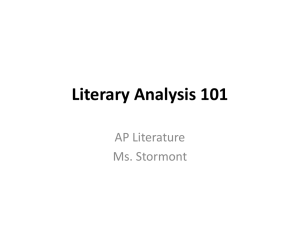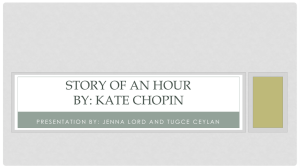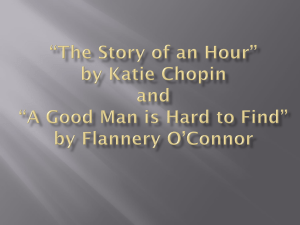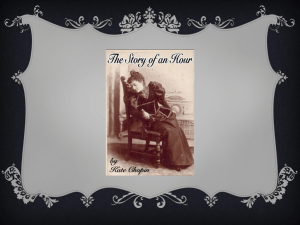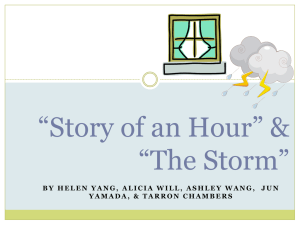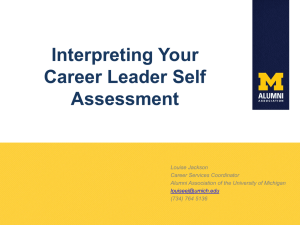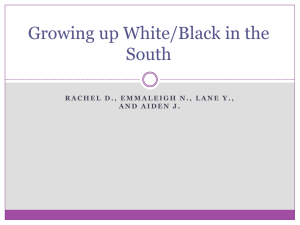The Story of an Hour
advertisement
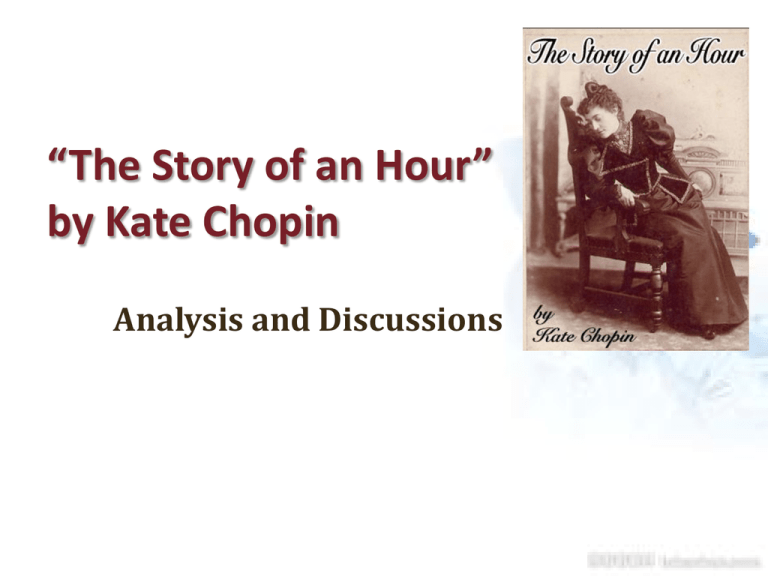
“The Story of an Hour” by Kate Chopin Analysis and Discussions Pre-reading discussion What can we do in an hour? 1. Play a game 2. See a movie 3. Enjoy a long nap But, do you believe an hour can make a woman live well become dead? “The Story of an Hour” Tasks Writer Background Answer the questions Theme Summarize KATE CHOPIN 凯特·肖邦 (1851~1904) A Woman Ahead Of Her Time The Writer: Kate Chopin Kate Chopin is one American’s most important women writers of the 19th century. Her representative work “Awakening” is recognized for performance pioneer of feminist thought. “The Story of an Hour”, published in 1894, is a boutique in Chopin’s short stories. The literary context of Chopin's work is debatable. She can be considered as a Southern women writer, a proto-feminist (a label she strongly denied), a local-colorist, a romantic, a realist, or a naturalist. In fact, her work may be characterized by ties to several literary "movements," ties which one might like to explore. Background The women in the 19th century were required to learn all the social graces and encouraged to follow the rules and principles as men wanted them do. They could do nothing, regardless of what they think. In other words, they had no freedom. The Story Leading characters: 1. Mrs. Mallard 2. Mr. Mallard 3. Mr. Mallard’s friend Richards 4. Mrs. Mallard’s sister Josephine Psychological Process 1. Sad for her husband’s death 2. Awakening 3. Discovering her own freedom 4. But she was dead finally Theme 1. Repression of women in a male-dominated society in the late 19th century expected women to keep house, cook, bear and rear children—but little more. “The Story of an Hour” hints that Mrs. Mallard’s husband— perhaps a typical husband of his day— dominated his wife. 2. Women’s aware of their identity in marriage Questions 1. What happened to Mr. Mallard? His name was on the list of “killed” according to intelligence of a railroad disaster, but at last proved to be a mistake. 2. What kind of a person was Richard? He was careful and tender. 3. How do you understand “she wept at once, with sudden wild abandonment in her sister’s arm”? At first, she was surprised and felt sad and heartbroken. For her husband was kind and tender, his face never looked save with love upon her, but now her husband was dead. 4. Why did Mrs. Mallard feel “free”? According to the background, women in America in the late 19th century had no status and all they could do was to serve their husbands. So, when she heard the news, she was sort of happy and thought she could live a new life out of her husband’s control. 5. What did the views, the scents, and the wounds outside the open window reveal about Mrs. Mallard’s inner feelings? The tops of trees were all aquiver with the new spring life, the breath of rain was delicious, the song and the twittering sparrows were the symbol of freedom to Mrs. Mallard. All the things energetic and full of life just reflect her inner desire to a free life. 6. What kind of life did Mrs. Mallard want? There would be no one to live for during the coming years, she wanted to live for herself. There would be no powerful will bending hers. 7. What caused Mrs. Mallard’s death? Did she really die of joy? Her deep despair when finding her husband was still alive and all her hope of the bright future was invalid drove her to death. 8. Can you imagine how Mr. Mallard would feel about his wife’s death? He might feel it was an unfortunate accident. 9. What’s the purpose of the author’s writing this story? She created the story to fight against the unfair treatment to women at that time and call on the whole society to rescue the poor middle-class women. 10. Why didn’t the writer tell us the first name of Mrs. Mallard until paragraph 15? Women were not taken seriously and nobody would pay attention to their first name, their existence was just like an auxiliary to the family. It is until paragraph 15 when Mrs. Mallard started to feel free that she was provided the first name. Four parts of the story 1.Exposition: Para 1-2 Mrs. Mallard was told that her husband, Brently Mallard, had been dead in the railroad disaster. 2.Elaboration: Para 3-7 Mrs. Mallard was so sad at the news that she wept in her sister’s arms. Then she went away to her room alone, and sat in the armchair, quite motionless, except a sob came up into her throat and shook her. 3.Climax: Para 8-20 She was waiting for something coming to her and then realized it was freedom . She found something more important than her insipid life—free. Both body and soul are free. 4.Denouement: Para 21-23 Mrs. Mallard died of heart disease suddenly when seeing her husband go back home. Four characters in the story • Mrs. Mallard • Josephine Mrs. Mallard’s sister • Richards A friend who told them the news that her husband was dead. • Brently Mallard Mrs. Mallard’s husband Antagonists Flat characters Mrs. Mallard protagonist & round character • Direct characterization: “She was young, with a fair, calm face, whose lines bespoke repression and even a certain strength.” (para 8) • Indirect characterization: “She wept at once, with sudden, wild abandonment, in her sister‘s arms. When the storm of grief had spent itself she went away to her room alone. She would have no one follow her. ” (para 3) “She sat with her head thrown back upon the cushion of the chair, quite motionless, except when a sob came up into her throat and shook her, as a child who has cried itself to sleep continues to sob in its dreams. ” (para 7) “She said it over and over under her breath: "free, free, free!" The vacant stare and the look of terror that had followed it went from her eyes. They stayed keen and bright. Her pulses beat fast, and the coursing blood warmed and relaxed every inch of her body. ” (para 11) “‘Free! Body and soul free! ’she kept whispering .” (para 16) …… Characters Mrs. Louise Mallard is the protagonist of the story. She is introduced as being "afflicted with a heart trouble", which is why great care is taken in telling her of her husband's death. She mourns her husband, but then begins to feel relieved and liberated. Mr. Brently Mallard is assumed dead until the end of the story when it is revealed that the news of his death was a mistake. Characters Josephine is Louise's sister who tells Louise of her husband's death. She embodies the feminine ideals of the time, acting as the picture perfect wife figure. Richards represents the standard image and expectations of the man during the time period - responsible for protecting women. However, he fails which could have been a bit controversial for the time period. Narrator's point of view an omniscient third-person narrator enable us readers to see everything in detail rather than be limited to the protagonist's point of view show integrated plots and multidimensional characters Third-person narrative The non-participant narrator provides access to Mrs. Mallard's life: her medical condition or state, her strict marriage, her lackluster relationship with her husband, her perspective on "love" she has for her husband, and her perspective on her newly awakened ideas on her personal freedom—which she associates with the death of her husband. Mrs. Mallard's health condition (para 1) her controversial perception of love (para 13) her frustrating marriage (para 13) All that happened to Mrs. Mallard after hearing her husband's death become understandable and reasonable. The sudden change of plots Sudden change of plots is a writing technique widely used in novels,dramas,especially tragedies. And its first use can date back to Ancient Greece, when Aristotle, a great philosopher at that time, specially discussed this skill in his Poetics. He pointed out that sudden turn meant actions opposite to what we called the principle of steering. Kate Chopin also introduced a plotchange into this short story. The death of Mr. Mallard led the whole story happen. But just when the plot reaches the climax, the unbelievable appearance of him ends the story, which totally astonishes us and solves all the doubts left in the very beginning. Function of this writing skill catch the eyes of the readers make the story more attractive, dynamic and varied. Irony • Verbal irony: someone says something that deliberately contradicts what that person actually means. • Situational irony: something happens that contradicts readers’ expectations. • Dramatic irony: reader or audience is aware of something that a character does not know. Authors may use irony to: • create humor • add an element of surprise to a story • develop a story’s theme—its central message. • When irony is used in this way, the theme of the work may concern a discrepancy between surface appearances and inner truths. Example of irony “when the doctors came they said she had died of heart disease – of joy that kills” At the end of the story, the doctors agree that she must have passed away from a sudden shock of extreme happiness from finding out that her husband lived after all. But in fact, she was killed by great depression of being a prisoner again. Doctors suggest that no one could understand her at that time. Thesis Live your life for yourself and not anyone else, because your chance at freedom may come to late in your life. “But she saw beyond that bitter moment a long procession of years to come that would belong to her absolutely. And she opened and spread her arms out to them in welcome.” Tone Begins with a calm logical tone. “Knowing that Mrs. Mallard was afflicted with a heart trouble, great care was taken to break to her as gently as possible the news of her husband's death.” Switches to more emotional and elated tone of a new found freedom. “They stayed keen and bright. Her pulses beat fast, and the coursing blood warmed and relaxed every inch of her body.” Purpose Women had boundaries set by men, and were thought to only live for their husbands or men in their life. Chopin wrote this to show how men weren’t the only means of happiness in a women’s life. Audience This story is mainly written for women. For women it was a way to show them that freedom may come to late in their lives so they should live their lives for themselves. Evidence When she sits by her window after crying she begins to notice the flowers blooming and many other things around her. Things only noticed when someone is happy. “There was something coming to her and she was waiting for it, fearfully. What was it? She did not know; it was too subtle and elusive to name. But she felt it, creeping out of the sky, reaching toward her through the sounds, the scents, the color that filled the air.” Appeals Pathos: Emotions revealed vary from sad, confused, joyful, and ends with a bittersweet death. “She did not stop to ask if it were or were not a monstrous joy that held her.” “Into this she sank, pressed down by a physical exhaustion that haunted her body and seemed to reach into her soul .” Assumptions Women’s lives were restrained to certain thoughts and emotions, not all could be evoked. “There would be no one to live for during those coming years; she would live for herself. There would be no powerful will bending hers in that blind persistence with which men and women believe they have a right to impose a private will upon a fellow-creature.” Style: Rhetorical Mode Descriptive: The essay develops through the accumulation of concrete and specific details revealing the repression of women by men as it is experienced by Mrs. Mallard. “She was young, with a fair, calm face, whose lines bespoke repression and even a certain strength. But now there was a dull stare in her eyes, whose gaze was fixed away off yonder on one of those patches of blue sky. It was not a glance of reflection, but rather indicated a suspension of intelligent thought.” Style: Syntax The story begins with a regular, logical and to the point sentence. As the story unravels we begin to get shorter sentences. “The delicious breath of rain was in the air. In the street below a peddler was crying his wares.” Style: Syntax (cont.) We also receive more pauses. (commas, semicolons, periods) “There was something coming to her and she was waiting for it, fearfully. What was it? She did not know; it was too subtle and elusive to name. But she felt it, creeping out of the sky, reaching toward her through the sounds, the scents, the color that filled the air.” This creates a more rapid tone then the beginning sentence. Ends with a simple sentence, “When the doctors came they said she had died of heart disease--of the joy that kills. ” Style: Others Simile: “…except when a sob came up into her throat and shook her, as a child who has cried itself to sleep continues to sob in its dreams.” Imagery: “She could see in the open square before her house the tops of trees that were all aquiver with the new spring life... and countless sparrows were twittering in the eaves. There were patches of blue sky showing here and there through the clouds that had met and piled one above the other in the west facing her window.” Irony: “When the doctors came they said she had died of heart disease--of the joy that kills.” In Class Assignment: discussion • Mrs. Mallard “did not hear the story as many women have heard the same”(story quote). What does this reaction suggest about her? Does it suggest how “ladies” were expected to react? • What does the setting description tell us about her ordinary life? • Who could consider Mrs. Mallard’s joy “monstrous”? Do you judge her negatively at this point? • How would this story change if it had been Mr. Mallard at home with heart problems hearing about Mrs. Mallard’s death? Title The title of the short story refers to the time elapsed between the moments at which the protagonist, Louise Mallard, hears that her husband is dead and discovers that he is alive after all. The Story of an Hour was considered controversial during the 1890s because it deals with a female protagonist who feels liberated by the news of her husband's death. In Unveiling Kate Chopin, Emily Toth argues that Chopin "had to have her heroine die" in order to make the story publishable. Tone An ironically detached and melancholy tone: The story comes off as subtly cruel in that Louise's reaction to the death of her husband was not one of sadness from loss but rather a bitter joy she feels when she comes to the understanding that she is now free from the shackles of marriage, his perceived death representing freedom and independence from the role she is forever bound to by society - a wife. Marriage vs. Freedom Mrs. Mallard believes that both women and men limit each other in matrimony. The story is not about the husband being abusive to his wife or vice-versa. Instead, it focuses on the individual's inner desires for freedom. Louise's desire for freedom far exceeds her love for him - a controversial idea that goes against the norms of society. Symbolism Spring –This symbolizes a new beginning which represents life and that is what Mrs. Mallard gains as a widow. It also helps to note that spring comes after winter. Mrs. Mallard’s Heart: She dies of heart failure triggered by overwhelming emotional stress. No one will ever know that the overwhelming emotional stress was due to her loss of hope for the future. Women's Liberation Movement In the story, this housewife who has been confined to the social norms of the obedient wife, has an unorthodox reaction to the death of her husband. She anticipates her newfound freedom from the suppression of her husband, of men, and becomes invigorated by it. This idea is one of the key values of the feminist movement, and thus "The Story of an Hour" was an important literary work to show a woman breaking from the norm of society. Film Adaptation The Joy that Kills, 1984 film adaptation, directed by Tina Rathbone. It was released in 1984 as part of the PBS series American Playhouse. Structure and Style In “The Story of an Hour,” Chopin employs specific structural and stylistic techniques to heighten the drama of the hour. The structure Chopin has chosen for “The Story of an Hour” fits the subject matter perfectly. The story is short, made up of a series of short paragraphs, many of which consist of just two or three sentences. Likewise, the story covers only one hour in Louise Mallard’s life—from the moment she learns of her husband’s death to the moment he unexpectedly returns alive. The short, dense structure mirrors the intense hour Louise spends contemplating her new independence. Just as Louise is completely immersed in her wild thoughts of the moment, we are immersed along with her in this brief period of time. This story can be read quickly, but the impact it makes is powerful. Chopin surprises us first with Louise’s elated (兴高 采烈的) reaction when she first murmurs “free” to herself. She shocks us again at the conclusion when she dies upon Brently’s return. The “heart disease” mentioned at the end of the story echoes the “heart trouble” discussed at the beginning, intensifying the twist ending and bringing the story to a satisfying close. Because such a short story leaves no room for background information, flashbacks, or excessive speculation, Chopin succeeds in making every sentence important by employing an almost poetic writing style. She uses repetition to highlight important points, such as when she repeats the word open throughout the story to emphasize the freedom of Louise’s new life. She has Louise repeat the word free over and over again as well, which is one of the few words Louise actually speaks aloud in the story and indicates how much she cherishes her newfound freedom. Besides repeating words, Chopin also repeats phrases and sentence structures to highlight important points. For example, Chopin writes, “She breathed a quick prayer that life might be long. It was only yesterday that she had thought with a shudder that life might be long.” The identical phrasing of the second half of each sentence reveals how drastically Louise’s life has changed—she once shuddered at the thought of a long life, but now she prays for it. Finally, Chopin makes the prose of the story beautiful by using alliteration and internal rhymes. For example, Josephine “revealed in half concealing” when she tells Louise the news, and Brently reappears “composedly carrying” his belongings. All of Chopin’s stylistic and structural techniques combine to make this very short story powerful. Important Quotations Explained 1. But now there was a dull stare in her eyes, whose gaze was fixed away off yonder on one of those patches of blue sky. It was not a glance of reflection, but rather indicated a suspension of intelligent thought. This quotation appears after Louise has gone alone to her room to deal with the news of Brently’s death. After an initial fit of tears, Louise looks out her window at the wide-open spaces below. This quotation is our first hint that Louise’s reaction to Brently’s death will be surprising and that Louise is very different from other women. Whereas most women would gaze reflectively at the sky and clouds, Louise’s gaze suggests something different, something shrewder or more active. What she sees as she gazes out the window is different from what other women would likely see after their husbands have died. Not long after this passage, Louise acknowledges the joyous feeling of independence that Brently’s death has given her. Here, at the window, the first breaths of these feelings are stirring, and her “intelligent thought” will quickly engage once again as she processes these feelings and allows herself to analyze what they mean. 2. She breathed a quick prayer that life might be long. It was only yesterday she had thought with a shudder that life might be long. This quotation appears close to the end of the story, just before Louise leaves her bedroom to go back downstairs, and illuminates the extent of Louise’s elation. Before Brently’s death, Louise viewed her life with trepidation, envisioning years of dull, unchanging dependence and oppression. The “shudder” she felt was one of dread. Now, however, she is free and independent, and her life is suddenly worth living. Whereas she once hoped life would be short, she now prays for a long, happy life. This passage, besides showing us how fully Louise feels her independence, also highlights the unexpectedness of Louise’s reaction. Rather than dread a life lived alone, this solitude is, for Louise, reason enough to anticipate the future eagerly. When Brently returns, she dies, unable to face the return of the life that she’d dreaded so much. Weeping Louise’s weeping about Brently’s death highlight the dichotomy between sorrow and happiness. Louise cries or thinks about crying for about three-quarters of “The Story of an Hour,” stopping only when she thinks of her new freedom. Crying is part of her life with Brently, but it will presumably be absent from her life as an independent woman. At the beginning of the story, Louise sobs dramatically when she learns that Brently is dead, enduring a “storm of grief.” She continues weeping when she is alone in her room, although the crying now is unconscious, more a physical reflex than anything spurred by emotion. She imagines herself crying over Brently’s dead body. Once the funeral is over in her fantasies, however, there is no further mention of crying because she’s consumed with happiness. The Open Window The open window from which Louise gazes for much of the story represents the freedom and opportunities that await her after her husband has died. From the window, Louise sees blue sky, fluffy clouds, and treetops. She hears people and birds singing and smells a coming rainstorm. Everything that she experiences through her senses suggests joy and spring—new life. And when she ponders the sky, she feels the first hints of elation. Once she fully indulges in this excitement, she feels that the open window is providing her with life itself. The open window provides a clear, bright view into the distance and Louise’s own bright future, which is now unobstructed by the demands of another person. It’s therefore no coincidence that when Louise turns from the window and the view, she quickly loses her freedom as well. Heart Trouble The heart trouble that afflicts Louise is both a physical and symbolic malady that represents her ambivalence toward her marriage and unhappiness with her lack of freedom. The fact that Louise has heart trouble is the first thing we learn about her, and this heart trouble is what seems to make the announcement of Brently’s death so threatening. A person with a weak heart, after all, would not deal well with such news. When Louise reflects on her new independence, her heart races, pumping blood through her veins. When she dies at the end of the story, the diagnosis of “heart disease” seems appropriate because the shock of seeing Brently was surely enough to kill her. But the doctors’ conclusion that she’d died of overwhelming joy is ironic because it had been the loss of joy that had actually killed her. Indeed, Louise seems to have died of a broken heart, caused by the sudden loss of her muchloved independence. Vocabulary 他们经常被过往的飞机搅得不安宁. They are always afflicted with the noise made by the passing planes. 怀有自卑感是很危险的. It's very dangerous to be afflicted with a sense of inferiority. 尽量预见你的孩子会干什么,并预先阻止 问题发生。 Try to anticipate what your child will do and forestall problems. 与其补救于已然,不如防范于未然. To forestall is better than to amend. 颜色与设计都显示了女性的优雅。 The color and the design both bespoke feminine grace. 他的彬彬有礼显示他是个绅士. His good manners bespoke the gentleman. 埃里克总是这样神出鬼没,哪儿也找不着. Eric, as elusive as ever, was nowhere to be found. 数是英语教学中的一个关键而又难以捉摸 的概念。 Number is a crucial but elusive concept in English teaching and learning. 群众正在进行声势浩大的示威游行. The crowd was demonstrating tumultuously. 一股强有力的反抗精神在他身子里排山倒 海似的汹涌起来. A mighty spirit of revolt heaved tumultuously within him. 世界上没有长生不老药。 There is no elixir of life in the world. 保持头脑清醒和灵活便是保持年轻的唯一 灵丹妙药. Keep your mind awake and active; that's the only youth elixir. 他的强硬要求让我只能答应而没有别的选 择. His importunity left me no alternative but to agree.

